Pilates
What Is Pilates?
The Pilates method of body conditioning is a unique system of stretching and strengthening exercises developed over ninety years ago by Joseph H. Pilates. It strengthens and tones muscles, improves posture, provides flexibility and balance, unites body and mind, and creates a more streamlined shape. The Pilates method, with more than nine decades of success, stands out as a tried-and-true formula of wisdom and unwavering results. Pilates was developed to create a healthy body, a healthy mind, and a healthy life, and people are ready to heed its message of balance.
"There's been a shift in awareness," explains Elizabeth Larkam, senior dance medicine specialist at the Center for Sports Medicine at St. Francis Memorial Hospital in San Francisco. "People are ready to be challenged, mentally and physically. The trend is toward workouts that recognize that mind-body connection," she says.
"Joseph Pilates understood that if the center of the body is strong, the body as a whole will function better," says Raymond Caelen, an instructor at Rancho La Puerta in Mexico. "You will have improved stability, balance, and coordination." We also want a workout that works. According to Larkam, the secret to the willowy Pilates look is the development of a strong core, a simpler way of saying the abdominal, back, and pelvic muscles.
The beauty of Pilates is that once you understand the core of its philosophy, its movements can be translated into any format. Each exercise is an important movement in and of itself and can be used as a way to stretch and move correctly in the course of one's day, but it is not a limited exercise regimen. Many people use the essence of the exercises to enhance other activities. Athletes, for example, employ the movements and philosophy of Pilates in their sports. But whether you're an athlete or a couch potato, young and limber or old and inflexible, the Pilates method can and does change the way you relate to your own body and the way you carry it in the world.
Philosophies Behind the Pilates Method of Body Conditioning
The Pilates method of body conditioning is not an arduous technique that leaves you tired and sore. In fact, quite the opposite is true. By allowing the movements to stretch your body as you simultaneously work on the strengthening elements of the method, you are creating a habit of relaxed effort for your body to follow. We are far too used to straining ourselves in the effort to strengthen our muscles when we should be enjoying the movements themselves.
Using Visual Images to Engage Your Mind and Body
Visual imaging creates a frame of reference for your body to follow. By asking your mind to conjure up images, the innate signaling system of your body is triggered. Like a telephone switchboard, images are routed through your brain and transferred to instinctual movements. Imagine how your body would react if you were punched in the gut. Not pleasant, but the thought alone is enough to trigger a physical response. Similarly, expressions such as "walking on air" or "a spring in your step" can be manifested physically.
The movements of the matwork will become as much second nature as skipping, twisting, reaching, or bending over to pick up a dropped pen. The benefit is that you no longer need to think of movement as belonging only in an exercise class. You will begin to trigger the same awareness in the movements of your daily activities that you have focused on in a class.
Making the Connection Between Pilates and Your Daily Activities
At first, the movements of the matwork may seem unconnected to your daily routine. However, with patience and persistence, you will begin to understand how the movements are merely tools to understanding your body. Once learned, muscle control can be applied to any function of physical movement, from walking and running to lifting and carrying.
Structured around the stomach, hips, lower back, and buttocks—the center of the body, or its "powerhouse"—the movements of the Pilates method are instrumental in maintaining good posture and alignment. These are key elements in proper muscle use and make even the most difficult daily tasks seem effortless.
Quality Versus Quantity
Just because it's not burning doesn't mean it's not working!
Pilates was designed to work directly with the deepest muscles in the body, creating a strong core without the pain associated with conventional exercises. And because you stretch your muscles as you strengthen them throughout the sequence of a Pilates workout, there is no fear of being improperly warmed up. There is no ripping of muscle tissue, jarring impact on your joints, or exhaustion of your muscles beyond effectiveness. Each movement has a prescribed maximum number of repetitions. The reasons for this is, assuming you are doing the exercise correctly, that you are working your muscles so precisely and efficiently that doing any more is completely unnecessary.
Committing to Physical and Mental Self-Improvement
In Pilates, as well as in life, there is nothing that will work for you that you do not make work for you. There is no good fairy who will come to you in the night and transform your body for you. The physical and mental commitment you must make to achieve your goal is the most important step in the process of change.
Believing in and following the Pilates philosophy will be the closest you come to making a miraculous change in the way you look and feel. Take the time to understand the essence of each exercise and to enjoy the freedom of movement, and in time you will create the results you are looking for.
Autonomy is a powerful tool against the risk of failure in exercise. For this reason, the Pilates matwork is designed with the intent of making you the master of your own fitness destiny. Whether you do five or forty-five minutes a day, committing yourself to your body is the key.
The Matwork Principles
While Pilates draws from many diverse exercise styles, running the gamut from Chinese acrobatics to yoga, there are certain inherent ruling principles that bring all these elements together under the Pilates name: concentration, control, center, fluidity, precision, breath, imagination, intuition, and integration. Of these nine principles, the following will be disclosed more fully:
- Control
Joseph Pilates built his method on the idea of muscle control. That meant no sloppy, haphazard movements. This is the primary reason injuries occur in other exercise methods. Imagine gymnasts, acrobats, or dancers performing their skills without control. Disastrous! The movements of the matwork are no different. They must be performed with the utmost control to avoid injury and produce positive results. No Pilates exercise is done just for the sake of getting through it. Each movement serves a function, and control is at the core. - Center
Think about the muscles you use to go about your daily tasks. For most people, it is the arms and legs that get used the most, but what about our center? We have a large group of muscles in our center—encompassing our abdomen, lower back, hips, and buttocks—that are begging for attention. Pilates called this center the "powerhouse." All energy for the Pilates exercises initiates from the powerhouse, or core, and flow outward to the extremities. Physical energy is exerted from your center to coordinate your movements. In this way, a strong foundation is built upon which we can rely in daily living. - Breath
Breathing is the first act of life and the last, and so it is imperative to learn to breathe correctly. In order to achieve his ideal of total fitness, Joseph Pilates designed his method to cleanse the bloodstream through oxygenation. By employing full inhalations and full exhalations, you are expelling stale air and noxious gases from the depths of your lungs and replenishing your body with fresh air to energize and revitalize your system. You will find that proper breathing will help to control your movements both during the exercises and in daily life. - Waiting to Exhale
While proper breathing is important in performing any exercise, in Pilates it is the foundation. "The breath is what allows you to access the deeper abdominal muscles," Caelen explains. All too often at the gym, we hit the mat and bang out a hundred quick crunches, which only engages the superficial muscles.
But the abdominal core, actually, is made up of layers of muscles. "By performing slow, controlled movements and breathing fully and deeply, you are able to activate a greater number of abdominal muscle fibers," Larkam says. "This is the secret to facilitating flat abs."
In Pilates, the breathing demands concentration. As you inhale through your nose, let the air fill your lungs and not your back or your abdomen. Your rib cage will expand, and your diaphragm will move down toward your pelvis. Then open your mouth and exhale completely, letting your lungs deflate. Your diaphragm moves up and your abdominal muscles go concave. "The more you exaggerate this movement, the deeper the abdominal contraction will be," Larkam explains.
Once you've mastered the art of the breath, turn your focus to form. "At first, you're simply learning how to engage the particular muscles," explains Caelen. If you perform the exercise properly, you'll get toned but never bulky, because you are working through a full range of motion against a light resistance. However, don't expect your workouts to get easier with time. "Easy is something that doesn't exist here," Caelen stresses. "The better you do the exercises, the harder they become. But if you're consistent, you may be surprised how quickly you can gain in deep muscle strength. - Integration
Integration is the ability to see your body as a comprehensive whole. Each exercise in the matwork employs every muscle from your fingertips to your toes. In the Pilates method, you will never isolate certain muscles and neglect others. The very idea of isolation creates an unbalanced body that impedes flexibility, coordination, and balance. Uniformly developed muscles are the key to good posture, suppleness, and natural grace. Through integration, you will learn to use every muscle simultaneously to achieve your goal. Your mind is the coach and the muscles of your body are your team. No one sits on the bench!
In addition to helping you build a strong, sinewy body, Pilates is the rehabilitation method of choice among countless athletes and coaches. If you've been sidelined with an injury, such as a back or knee problem, Pilates may be the perfect way not only to retain strength but also to build it while you ease back into your regular activities.
Key Elements to Mastering the Mat
In order to gain the most from your mat workouts, it is important to understand the key elements that are in play.
Redefining the Body
Classically, we have thought of the body as two arms, two legs, a torso, and a head. In the matwork, the key to understanding the movements comes from imaging the body in its simplest form: the torso. The torso (see Fig. 1) encompasses the space starting from just beneath the skull and continuing down to the bottom of the buttocks. It contains the vertebral column (spine) and all the major organs. The "powerhouse or core," from where the exercises initiate, is also contained within the torso. By visualizing the body in this form, it is easier to understand the essence of the exercises.
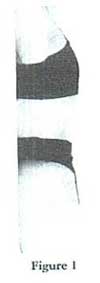
Your Powerhouse
All Pilates exercises initiate from the muscles of the abdominals, lower back, hips, and buttocks (see Fig. 2). The band of muscles that circles the body just under your belt line is termed the "powerhouse."
When performing the mat exercises, remember that you should be constantly working from the powerhouse and lifting up and out of this region. Imagine stretching your upper body away from your hips as if you were being cinched in a corset. This action of pulling up and in simultaneously will automatically engage our powerhouse muscles and help protect your lower back.
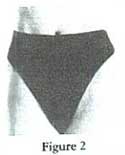
"Scooping Your Belly," or Navel to Spine
When doing the mat exercises, you will learn to "scoop" your belly, or press your navel to your spine, thereby using the abdominal muscles to reinforce the paraspinals (muscles that run alongside your spine). This action not only strengthens and stretches the muscles of the lower back considerably but also allows for the creation of a flat abdominal wall.
It will help if you visualize a weight pressing your belly down to your spine or an anchor attached to your belly button from the inside and pulling it down through the floor (see Fig. 3). Learn to maintain this feeling while breathing normally, that is, taking in and expelling air from the lungs and not from the belly, as taught in many other techniques.
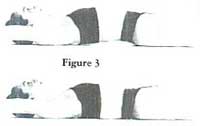
Tucking Under Versus Lengthening
In Pilates, it is key to keep lengthening your muscles as you strengthen them, therefore, any movement that instructs you to "squeeze your buttocks tightly" is not meant to cause you to tuck your bottom under or contract your muscles so strenuously that your bottom curls up off the mat. Ideally, your pelvic and the base of your spine should stay pressed against the mat or be held firmly in position by the surrounding muscles of the powerhouse.
Integrated Isolation
When performing the mat exercises, it is important that every muscle of the body be working simultaneously, since that is the natural inclination of the body and also maintains the body's sense of balance. In order to achieve this goal during the matwork, it is most effective to think of focusing on stabilizing, or anchoring, the area of the body that is not in motion. For example, in the Roll-Up (see Fig. 4), by focusing your mind on stabilizing your body while your upper body is in motion, the muscles of your entire body are engaged and integrated.
When you attempt this exercise focusing only on the lifting and forward motion of the upper body without first anchoring and focusing on the lower body, you create a very sloppy and ineffective exercise that can lead to injury.
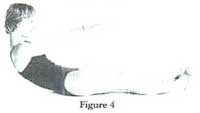
Stabilization Using The Pilates Stance
When standing in the Pilates position, "squeeze the backs of the upper inner thighs." Let the hips initiate a slight turnout of the legs, which engages and stabilizes the lower body. This slight movement disengages the quadriceps (thigh muscles) and engages instead the target areas of the hips, buttocks, and outer and inner thighs. Think of turning your thighs to face away from each other and holding, a tennis ball between them (see Fig. 5). Your feet should remain in a small V position with the heels glued together. Your knees should remain "soft," straight but not locked.
Continue squeezing the buttocks and backs of the upper inner thighs together and feel the effort created throughout the entire torso as you do so.
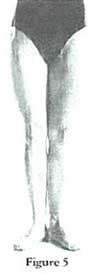
Muscle Control Without Tension
One of the most difficult concepts of the matwork for most people is the idea of engaging and controlling the muscles without tensing. We have become conditioned to tense up, hold our breath, and push to the point of strain in order to achieve our exercise goals.
Think about a dancer as he/she performs. While you know how much strength and effort it takes to perform the complicated dance moves, it often appears effortless and natural. The same principle is at work while performing the mat exercises. While the movements require strength and concentration, there should always be a natural flow and rhythm that serve to relax the muscles without disengaging them from their task. This relaxation needs to begin in the mind and circulate throughout the muscles of the body. Breath is an effective tool for achieving this state. While the breathing should feel natural, inhaling at the beginning of a movement and exhaling throughout its completion, there are times you will find you are holding your breath because the exertion is too great. This defeats the purpose of the exercise. Make sure that (1) you have made the necessary modifications to ensure that you are working at the proper level for your body and (2) you are not tensing your muscles as you perform the movements.
Modifications for the Most Common Pains and Injuries
No exercise in the Pilates method should cause pain. Ever! If you find an exercise putting an uncomfortable strain on an area of your body, stop, review the instructions to make sure you are working from the proper muscles, and try again. If you still experience pain, leave that exercise out for now. As your strength and control increase, you will be able to come back to that exercise in time. Remember that some exercises may not be suited to your individual body. Use your best judgment and listen to your body!
Lower back pain is most often caused by pushing your abdominal muscles away from your back, leaving little support for the muscles of the spine. To combat this habit, focus on pulling the navel to your spine, as if the actual belly button is, in fact, a button that is fastened to your spine. The deeper the stomach "sinks" in your spine, the safer your back will be. When horizontal, imagine a heavy metal plate anchoring your belly to the mat beneath you. When vertical, imagine a rope through your center pulling your belly back.
Knee pain is most often caused by improper foot and leg positioning or by gripping or overextending the muscles around the knee joint. Try to maintain a "soft" knee while executing the movements, and use the muscles of the inner thighs and buttocks to compensate instead. Throughout most of the exercises, and especially while standing, use the Pilates stance to support your weight.
Neck pain is most often due to weak muscles or tightening your shoulder to support that weakness. As you perform the movements of the matwork, remember to stay lifted using the muscles of your abdominal region and not the neck itself. Always lower your head and rest when you feel you are exerting too much effort from your neck. If needed, you can place a small pillow under your neck for support.
Lengthening Your Neck
It is a common mistake in Pilates to tense up in the shoulders as you perform some of the movements. In order to avoid this bad habit, it is important that you think of lengthening the vertebrae just below the skull by pressing the back of your neck toward the mat when lying flat or pressing out through the crown of your head when sitting, standing, or stretching forward. This adjustment will release the muscles of the neck and shoulders and allow you to focus on your powerhouse instead. Think of bringing your chin closer to your chest to achieve this sensation. (See Figs. 6 and 7).
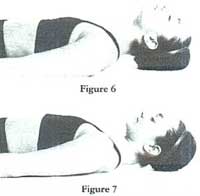
Frequently Asked Questions
What is my goal with the matwork?
By using the matwork movements and philosophy, you will create a system that is the most beneficial to your individual body and lifestyle. You are re-teaching your body lessons of correct form and movement that will stay with you for a lifetime. Your overall goal is to break bad habits and connect to and form an alliance with your body. For most, this means the enjoyment of moving correctly and reaping the benefits of what that brings: better posture, a strong center, suppleness, alacrity, and a feeling of well-being.
If you are working to advance to the higher matwork level, then your goal is to hone your routine to where you can add new exercises without sacrificing time. This in no way means that you should speed through what you already have learned to get to something new. You want to move with rhythm and dynamic but without surrendering control. Effort and sweat are sure signs that you are accomplishing your goal, but strain and sloppiness are not!
Will I be able to do this if I have not been exercising regularly?
As with any exercise program, it is important to check with a sports medicine physician before beginning. If you are pregnant, injured, or in any way incapacitated, it is imperative that you get the approval of your personal physician.
However, the Pilates matwork is designed to accommodate any level of fitness. Understanding that the Pilates method is a corrective system of exercise in which you will progress in stages is also key.
What kind of a mat should I use and where?
Any mat or pad that is thick or dense enough to support and protect the delicate vertebrae of your spine will do. A thick carpet or long, folded blanket may also do the trick.
What should I wear?
Workout clothing (leggings, tank tops, and so on) is the most practical and will allow you to see the muscles you are working, but any comfortable clothing will do.
When is the best time to do the matwork?
Doing the exercises is what's important; it matters less when you do them.
Some people prefer to begin their day with the matwork to wake up, and some use it to relive stress at the end of their day.
How many times a week should I do the matwork and for how long?
Joseph Pilates used to recommend committing to the matwork four times a week for fifteen to thirty minutes each session. This number will change in stages. Some longtime students of the mat can perform the entire advanced sequence in fifteen minutes and not sacrifice the precision of the movements.
Getting Started: Beginning Matwork
You can start the Pilates exercise program by purchasing the book "The Pilates Body" by Brooke Siler, which has an easy-to-follow instruction manual. In a tribute to Brooke and her book, I extensively quoted her to write the "What is Pilates?" article. In Fresno, you can sign up for formal Pilates classes with select instructors, such as Cathy Piche at the Dance Studio of Fresno or Karin Oliver at KO Pilates at Studio Z Pilates.
- The Dance Studio of Fresno
- 7491 North Palm Bluffs Avenue
- Fresno, CA 93712
- Phone: (559) 307-5912
- KO Pilates
- Home Studio located in Auberry, CA
- Phone: (559) 389-1694

About Cathy Piche: She was one of the first AFAA-certified instructors to introduce Pilates to the fitness industry of Fresno. She incorporates the Pilates method to heighten her own personal athletic performance. She is also a certified marathon and triathlon coach who has completed several challenging events, including adventure racing, triathlons, and marathons. She is enthusiastic about sharing the benefits of Pilates and bringing you to a new level of fitness.
About Karin Oliver: Student of Pilates since 2016 and Classical Pilates Comprehensive Certified (CPCC). An interpersonal and experienced athlete with a passion for education and motivating students to achieve new levels of excellence.
Specialty Reference
Sports Medicine Center